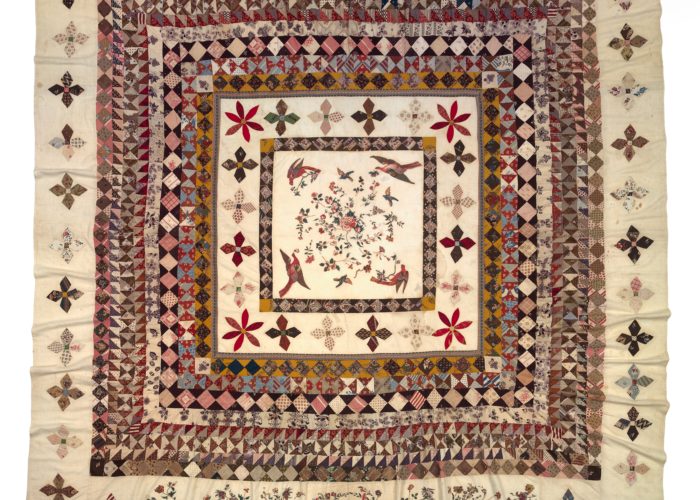The Rajah Quilt
Theme: Social and cultural revolution, People in motion: exiles and opportunities
Transportation was an extremely harsh punishment of the 1700s and 1800s, second only to execution. Between 1787 and 1852 as many as 25,000 women were transported from Britain to Australia to work in penal colonies, for crimes as varied as petty theft and poaching, to murder. Their sentences were often miscarriages of justice. Many didn’t survive the long journey. Most of them never returned. This remarkable quilt was made by women transported to Tasmania in 1841.
The conditions on convict ships were appalling and unsanitary. Groups of women were shackled and held in tiny, filthy, airless spaces. The mothers among them had to make the painful choice of whether to take babies with them or to leave them behind – probably to never see them again. Disease was rife and many died as a result. On arrival in Australia the women would be forced into exhausting menial and physical work, often as domestic servants.
After learning of the terrible conditions experienced by inmates in Newgate prison, the social reformer Elizabeth Fry began visiting women held in prison and on convict ships, awaiting transportation. Elizabeth and her colleagues held religious services for the women, taught them simple skills and gave them knitting and sewing materials. It was these materials that were used to make the Rajah quilt.
This beautiful and intricately crafted quilt was made by 180 women on board the ship Rajah, on their long transportation voyage from Woolwich Docks in London, to Van Dieman’s Land (now Tasmania). The quilt is 325cm x 337cm in size – about twice the size of a double bed – and an extraordinary example of what can be achieved under the most abject conditions. On arrival, it was presented to Lady Jane Franklin, the wife of the Lieutenant Governor. The quilt includes the following inscription sewn into the border, a reference to the kindness of Elizabeth Fry and her colleagues:
To the ladies of the convict ship committee, this quilt worked by the convicts of the ship Rajah during their voyage to van Dieman’s Land is presented as a testimony of the gratitude with which they remember their exertions for their welfare while in England and during their passage and also as a proof that they have not neglected the ladies kind admonitions of being industrious. June 1841.
The quilt was sent back to Elizabeth Fry in Britain, but it is not known whether she ever received it. Its whereabouts from then on was unknown until it was rediscovered in 1987. It is now one of the National Gallery of Australia’s most treasured items.
Did you know..?
Quilting dates back 5000 years to the ancient Egyptians and is still popular around the world today. The world’s largest quilt is the AIDS memorial quilt which weighs about 54 tons – the weight of eight elephants.
Sources & acknowledgements
This object description and its related educational resources were researched and written by our team of historians and education specialists. For further information see the item’s home museum, gallery or archive, listed above.
-
Did you know..?
Quilting dates back 5000 years to the ancient Egyptians and is still popular around the world today. The world’s largest quilt is the AIDS memorial quilt which weighs about 54 tons – the weight of eight elephants.
-
Education overview
You can access a range of teachers resources related to this object and more on our education page.
Please also see our glossary of terms for more detailed explanations of the terms used.
-
Curatorial info
- Originating Museum: National Gallery of Australia
- Accession Number: NGA451739
- Production Date: 1841
- Creator: British women on route to Tasmania aboard the convict ship Rajah
- Material: Textile
- Technique: Quilting, embroidery
- Size: 325x337 cms
- Original record
-
Use this image
Teachers can download this image for personal and educational use but please take note of the license type and rights holder information.
- Rights Holder: © National Gallery of Australia, Canberra / Gift of Les Hollings and the Australian Textiles Fund, 1989 / Bridgeman Images
- License Type: All Rights Reserved



